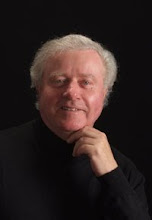I think that visiting Barcelona and talking about Spain must be equivalent to visiting Montreal and talking about Canada. I'll avoid the temptation and keep my remarks within the borders of Catalonia, the province that holds Barcelona.
Although the Spanish economy is said to be slow in its pull out of the depression, I did not get the same sense for Barcelona. It's reported that Barcelona has about 3,000,000 inhabitants - I think I met everyone of them on my many walks on the mile long pedestrian mall, the Rambla. I have no idea where all of these people were going, all day and all night.
They certainly weren't going into the brand retail shops at the upper end of the Rambla. These shops were nearly vacant except for some specialty stores like Nespresso. But the people were rushing, generally well dressed, somewhere.
Barcelonians tell you that their natural harbor is the biggest port for cruise ships. I can believe it. The ships are huge as you see them docked in the modern harbor. But as I look up the shoreline I see thousands of shipping containers laying idol in the yards. Maybe the local economy is slower than I think.
But some of those people on the Rambla are from the cruise ships. They make their way up from the docks and flood into the narrow side streets for tapas and paella. The wine and sangria are excellent, but not so much so for the beer. Tourism will be good to Barcelona. The local people care about their city and is shows in the way they keep it clean.
But if you want to see a strong sub-economy, work your way to the Sagrada Familia. This was a WOW moment in my life. The Sagrada is Gaudi's glorification of Christianity. When you see the towers your reaction has to be wow!
Construction starte
 d more than 100 years ago. Completion is anticipated in 2050. I've stood in the center of many cathedrals such as Chartres in France. I am always awestruck by the architectural and engineering brilliance required to build these monuments. But they were completed - usually hundreds of years ago.
d more than 100 years ago. Completion is anticipated in 2050. I've stood in the center of many cathedrals such as Chartres in France. I am always awestruck by the architectural and engineering brilliance required to build these monuments. But they were completed - usually hundreds of years ago.Not so for the Sagrada. It's still being built. As I stood in its vacant interior I felt the flow of history going through this point out to 2050. Just think, hundreds of years from now people will stand in Sagrada, marvel at its grandeur and wonder about the lucky people who saw it being built.
The Sagrada is a culmination of Gaudi's life long study of organic architecture. The mathematical study of a leaf, a vine, or a fern and then its translation into a building. Brilliant, but at times gaudy - oooops?
The economy slows down as you get outside the city. I took a two hour train ride to Figueres the birthplace and home of Dali. The theatre-museum that he left to the city is truly an architectural marvel; however, I never was a fan of surrealism and seeing his work in person didn't convert me.
Figueres is a quaint town but I have to wonder how long this type of culture can survive. Like many small towns in Europe it is built around its daily market. But as the train takes people to and from work you have to wonder how long the self-sustaining farming tradition will survive. It's sad, but globalization and digital wireless seem to have a stronger future than the vegetable gardener and butcher of Figueres.
One thing you won't find in Barcelona is a love of bullfighting. Yes, they have a ring but the continuance of fighting is questionable every year. Bulls are not bred in Catalonia. Fighting is an import from "Spain" and the Catalonian blood runs thin from Spain but deep from Northern Italy and Southern France. There just isn't a deep tradition for the kill as Hemingway describes in Death in the Afternoon.
It's hard to judge how well customers are valued when you're unfamiliar with the language and traditions. However, from my limited interactions I think all is well. Barcelona is high on my "must return" list.

